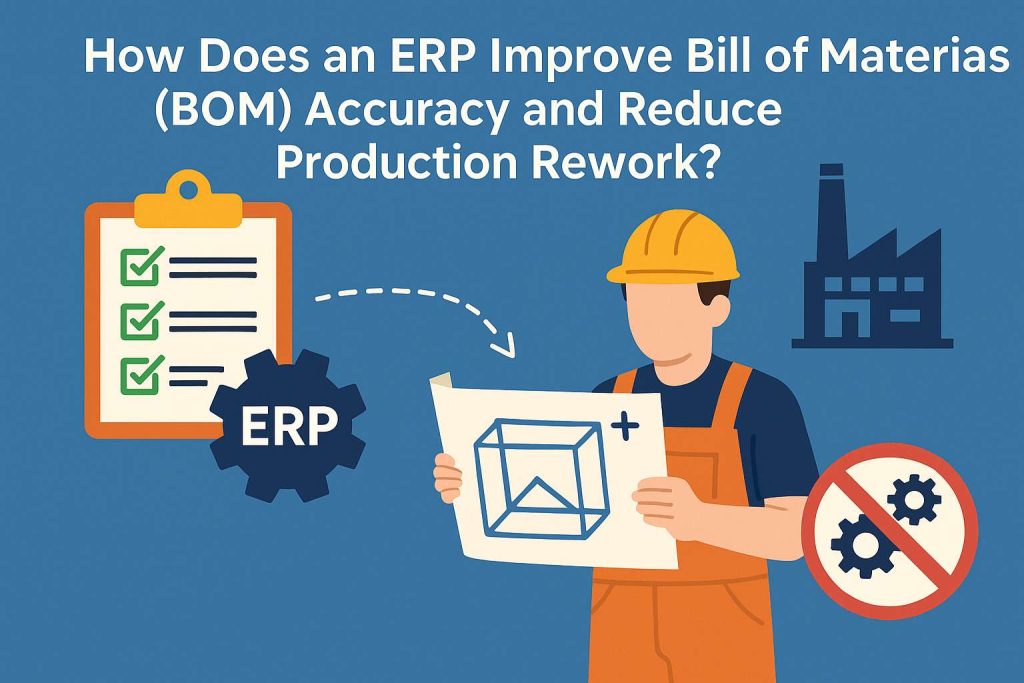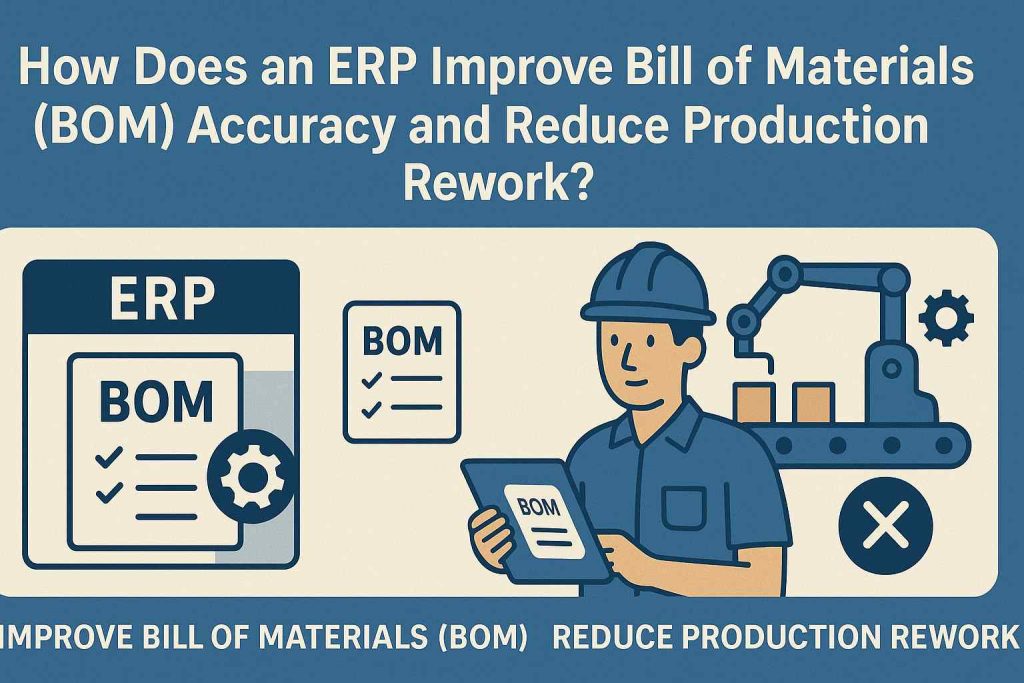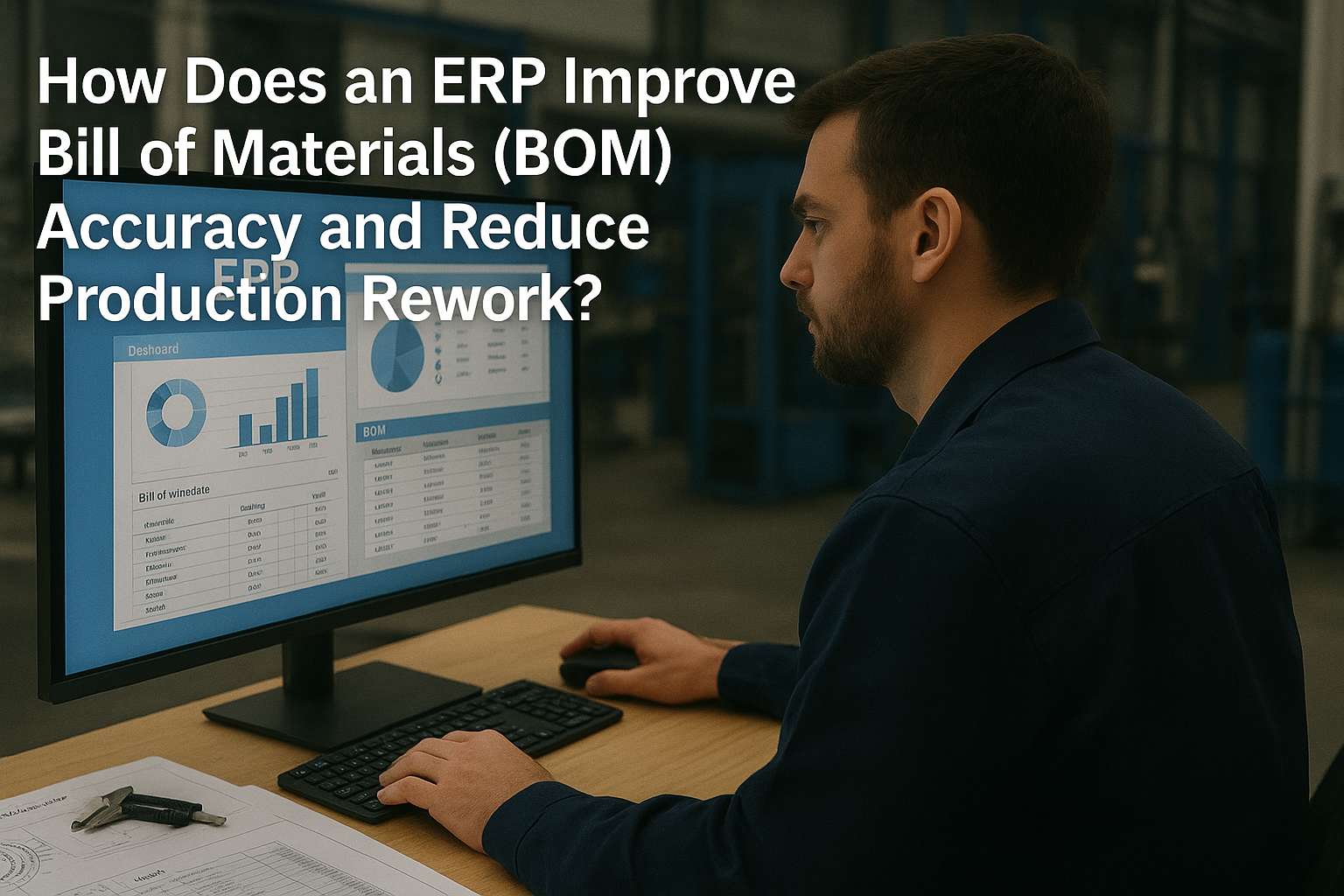Manufacturing has always been a game of precision. In industries where one wrong nut, a missing washer, or an outdated specification can halt an entire production line, precision becomes the language of survival. Every component, every sub-assembly, every process is defined, documented, and executed through one crucial document — the Bill of Materials (BOM). A BOM is more than a list of items; it is the DNA of the product, the connecting tissue between design, procurement, production, and quality. But the very same BOM, if inaccurate, outdated, or inconsistently managed, becomes the silent root of inefficiency, waste, and production rework.
Over the past two decades, as manufacturing has evolved from manual control to digital ecosystems, the way we manage BOMs has also transformed. The modern manufacturing world no longer tolerates disconnected spreadsheets or human-managed documents. Today, Enterprise Resource Planning (ERP) systems have become the backbone of manufacturing control, linking every department under a unified source of truth. Among the next-generation ERP solutions, WiderERP, developed by Zymofar Dynamic Products Pvt. Ltd., stands out as a comprehensive, customizable ERP built precisely for industries that value accuracy and control.
This article explores in detail how an ERP system — specifically WiderERP — improves Bill of Materials accuracy and drastically reduces production rework by digitizing, connecting, and automating every link in the manufacturing chain.
What Is a Bill of Materials (BOM)?
A Bill of Materials, at its simplest definition, is the structured list of all materials, components, assemblies, and sub-assemblies required to manufacture a finished product. However, in practical manufacturing environments, the BOM is much more complex and multifaceted. It defines not only the materials but also the hierarchical relationships between them — parent-child dependencies, version control, routing sequences, alternate materials, and process documentation.
For instance, consider a manufacturer producing industrial air compressors. The compressor’s BOM may include hundreds of components: pistons, valves, motor housings, gaskets, seals, electronic controllers, wiring harnesses, lubricants, packaging materials, and more. Each of these elements must not only be listed but also quantified correctly, linked to the correct supplier, and synchronized with the right process routing. A single omission — such as an incorrect motor specification or missing seal — can cause a production halt, quality issue, or even product recall.

Component-Level Table (Practical Excerpt)
Table: Compressor — BOM Excerpt (Component-level details)
| Component Description | Quantity per Unit | Unit of Measure | Preferred Supplier | Supplier Part No. | BOM Revision |
|---|---|---|---|---|---|
| Motor, 5 HP, 3-phase | 1 | Nos | Apex Motors Pvt. Ltd. | AM-5HP-3P-2024 | REV-B |
| Piston Assembly (Std) | 2 | Nos | Precision Gears Ltd. | PG-PIST-STD-01 | REV-C |
| Valve, Pressure Relief | 1 | Nos | FlowSafe Components | FS-VPR-150 | REV-A |
| Gasket Kit (Compressor) | 1 | Kit | SealTech Industries | ST-GK-COMP-01 | REV-D |
| Wiring Harness (Controller) | 1 | Nos | Electra Connectors | EC-WH-CTRL-02 | REV-B |
| Lubricant, Compressor Oil | 0.5 | Ltr | LubriPlus Distributors | LP-OIL-32 | REV-E |
This table shows the core fields a BOM must keep synchronized: component description, exact quantity per finished unit, unit of measure (UOM), preferred supplier and supplier part numbers, and the active BOM revision. If any of these fields diverge between engineering, procurement, and production, rework and delays follow.
The Traditional Approach and Its Limitations
Before digital transformation, most manufacturers managed BOMs manually, using Excel sheets, Word documents, or isolated inventory tools. Each department — engineering, procurement, production, and finance — maintained its own version of the BOM. Changes made in one department were rarely communicated to others in real time. This siloed management created duplication, confusion, and operational inefficiency.
In the design department, engineers often created multiple revisions of a BOM as they refined product designs. These revisions were circulated via email or printed copies, with no clear record of which version was approved for production. Procurement teams, working on older versions, ordered materials that didn’t match the updated designs. Production teams, unaware of the latest changes, assembled components that didn’t fit. Quality control teams discovered errors only after production — leading to expensive rework, scrapping of materials, and delayed customer deliveries.
The financial cost of these inefficiencies was enormous. Studies have shown that nearly 60% of rework in manufacturing environments originates from inaccurate or outdated BOM data. Without an integrated system to control revisions and synchronize changes, every change increased complexity instead of improving quality.
The ERP Revolution — How Digital Integration Changes Everything
The introduction of ERP systems brought a paradigm shift in how manufacturing organizations manage their BOMs. An ERP system unifies all business processes into a single digital ecosystem — ensuring that every department accesses and updates the same set of data in real time. Instead of isolated Excel sheets or manual approvals, ERP software offers centralized control, automated versioning, approval workflows, and instant communication between departments.
In the case of WiderERP, the system has been built from the ground up with the understanding that no two manufacturers are identical. Whether a company produces automotive parts, industrial machinery, food packaging materials, or electrical components, WiderERP adapts its BOM structure to match the organization’s real-world process flow. It ensures that the engineering team’s design intent translates directly to the shop floor without misinterpretation, delay, or data loss.
WiderERP transforms BOMs from static documents into live, dynamic digital entities. Every revision, approval, material linkage, and cost change is tracked automatically. The moment a design engineer updates a component or substitutes a material, the system instantly reflects this change in procurement, inventory, and production modules — ensuring that everyone works from the same page.
How ERP Improves BOM Accuracy — Practical Mechanisms Explained
Centralized Data and Version Control
In a manual setup, multiple versions of a BOM float across teams, creating confusion. ERP consolidates all BOMs into a central database. Each product, assembly, or sub-assembly has one master record. WiderERP assigns unique identifiers and maintains revision histories automatically. Any change in design or specification creates a new version, while old versions are archived for reference.
The system maintains full traceability — who made the change, when, and why. Production cannot begin without the latest approved version. This ensures that every department — from design to dispatch — works with synchronized, validated information.
Engineering Change Management (ECM) — Workflow That Prevents Mistakes
Engineering changes are inevitable. Customers request modifications, suppliers discontinue materials, and production engineers suggest improvements. Without an ERP, these changes often go unrecorded or undocumented. WiderERP implements structured Engineering Change Requests (ECRs) and Engineering Change Orders (ECOs). Each ECR is routed for review — design reviews it technically, production checks feasibility, and management approves final implementation. Once approved, the ECO automatically updates all affected BOMs and work orders. This controlled process ensures accountability, auditability, and transparency. It prevents unapproved changes that often lead to product inconsistencies.
Seamless Communication Between Departments
In a typical manufacturing environment, the biggest challenge is communication delay. A design engineer may finalize a change, but procurement might still be ordering the old material. ERP eliminates that gap. Once the engineering change is approved, WiderERP sends instant alerts to procurement, planning, inventory, and finance. Purchase requests are automatically adjusted, stock reservations updated, and costing recalculated. This tight integration prevents duplication, eliminates bottlenecks, and guarantees that production always uses the correct material specifications.
Real-Time Integration with Inventory and Procurement
ERP connects BOMs directly to material inventory and purchasing systems. When a production order is released, the system checks the BOM requirements against available stock. If quantities are insufficient, WiderERP generates purchase requisitions automatically. This automation guarantees that production never stalls due to missing materials — while simultaneously preventing overstocking.
Every material transaction, from purchase to consumption, updates stock records in real time. The system maintains accurate material balance, batch tracking, and supplier traceability. In case of defective materials, manufacturers can instantly identify which batches and products were affected.
Multi-Level BOM and Sub-Assembly Management
Manufacturing today is modular. A single product can have multiple layers of sub-assemblies. ERP software like WiderERP supports multi-level BOMs that mirror this real-world complexity. Each sub-assembly has its own BOM, linked hierarchically to the parent product. When an engineer modifies a sub-component, the system automatically updates its parent assembly. This cascading update ensures complete structural integrity, eliminating discrepancies that occur in manual systems where sub-BOMs remain disconnected.
Validation, Error Prevention and UOM Consistency
ERP systems include built-in data validation. WiderERP prevents users from saving incomplete or inconsistent BOMs. If a component’s unit of measure doesn’t match the defined standard, the system issues a warning. If a part doesn’t exist in the item master, the system blocks the entry. These validation rules enforce data discipline and eliminate human errors long before they reach the production floor. Automatic unit-of-measure conversions prevent mismatches between engineering specs, procurement orders, and store receipts.
Real-Time Shop-Floor Control and Feedback
BOM accuracy is meaningful only if it translates to error-free execution on the floor. WiderERP integrates directly with production terminals and workstations. Before an operator begins work, the system verifies the BOM version, required materials, and routing sequence. If any component or instruction is outdated or missing, the ERP halts the operation.
As production progresses, operators record actual material usage, scrap quantity, and time taken. These real-time feedback loops allow managers to compare planned vs. actual performance. If material consumption deviates significantly, the system flags it for review — helping identify potential training issues, process bottlenecks, or design flaws.
The Direct Link Between BOM Accuracy and Rework Reduction
Rework is the hidden cost that silently erodes manufacturing profits. It consumes labor, materials, and time without creating additional value. The root causes of rework almost always trace back to information failure — incorrect specifications, missing materials, wrong quantities, or unauthorized design changes.
ERP addresses rework at its root. Because every production order, material issue, and routing step references a validated BOM, there is no ambiguity about what needs to be built and how. Version control ensures that no operator uses an outdated drawing or specification. Material validations guarantee that only approved components are issued from stores. Change control prevents unrecorded deviations.
Furthermore, the system’s audit trail identifies exactly when and where deviations occurred. Managers can trace which operator used which batch of materials on which work order — allowing precise corrective action instead of broad blame. Over time, this traceability builds a culture of accountability and precision across the organization.
In real-world implementations of WiderERP, manufacturers have reported rework reductions of up to 85% within the first six months of go-live. This translates to significant savings — both in material costs and production hours.
Data-Driven Decision Making through BOM Analytics
When BOMs live within an ERP ecosystem, they become powerful sources of analytical data. WiderERP provides dashboards and detailed reports that visualize consumption variance, material wastage, cost deviations, and revision frequency.
By analyzing this data, manufacturers can identify patterns. For example, if a particular part consistently causes rework, engineering can revisit its design. If material wastage is high for a specific process, production can adjust machine settings or supplier selection.
Over time, this continuous improvement cycle turns BOM management from a reactive activity into a proactive strategy. Decision-makers gain a clear view of production health, cost trends, and quality consistency — all driven by the integrity of BOM data.

Traceability, Compliance, and Customer Confidence
In industries like automotive, electronics, pharmaceuticals, and food processing, traceability isn’t optional — it’s a regulatory requirement. ERP ensures that every component used in production can be traced back to its origin. From supplier lot numbers to work order records, every transaction is digitally logged.
If a customer reports a product issue, manufacturers can instantly trace the product’s entire material lineage. They can identify which supplier batch, production shift, and operator were involved — and isolate the issue without recalling unaffected products. This level of control not only prevents losses but also enhances customer trust.
During audits, ERP-generated reports serve as digital proof of compliance. Auditors can access revision histories, approval logs, and batch records instantly, eliminating the need for manual document collection.
WiderERP in Practice — Transforming Real-World Manufacturing
WiderERP is not just theoretical software. It is a system developed through years of understanding the ground realities of Indian manufacturing — multi-plant operations, dynamic workforce, fluctuating supplier networks, and complex GST-compliant financial structures.
When implemented in a mid-sized automotive parts manufacturing plant, WiderERP centralized more than 2,500 unique BOMs, each with multiple revisions. Before ERP, the company struggled with frequent component mismatches, material shortages, and duplicated orders. Within six months of implementing WiderERP, BOM accuracy improved to 99.7%, material variance dropped by 80%, and rework costs declined from ₹6 lakh per month to less than ₹1 lakh.
Another case from a packaging manufacturer revealed that WiderERP’s integration between BOM and quality modules reduced customer rejections by 70%. The system automatically linked inspection parameters to each BOM line item, ensuring that every batch met specification before dispatch.
Quantified Business Benefits — KPI Table
Table: Representative KPIs — Before and After WiderERP Implementation
| Key Performance Indicator | Before WiderERP | After WiderERP (6 months) | Net Improvement |
|---|---|---|---|
| BOM Accuracy | 70–80% | 99.7% | +19.7–29.7 pts |
| Material Variance (wastage) | 8–10% | <2% | 75–80% reduction |
| Rework Cost (monthly) | ₹4–8 lakh | < ₹1 lakh | ~75–85% cost saving |
| On-Time Delivery | 78% | 96% | +18 percentage points |
| Production Cycle Time | 10 days | 6 days | -40% |
| Audit Preparation Time | ~3 weeks | ~3 hours | ~90% faster |
These representative metrics show how improved BOM control translates directly into operational, financial, and compliance gains. They are the measurable proof that a controlled BOM ecosystem does more than tidy up documents — it multiplies performance.
Why WiderERP Stands Apart
What makes WiderERP ideal for modern manufacturers is its adaptability. While most ERPs force businesses to fit into rigid workflows, WiderERP molds itself around the company’s existing processes. It supports both discrete and process manufacturing, multi-level BOMs, engineering revisions, and localized regulatory compliance — all within one cohesive platform.
It’s designed for manufacturers who demand control, transparency, and real-time insights. From small workshops to multi-location enterprises, WiderERP scales seamlessly. It connects design, inventory, purchase, production, quality, and finance — enabling a true 360° view of operations.
Moreover, its intuitive interface ensures that even non-technical staff can manage complex data effortlessly. Managers can approve revisions from mobile dashboards, track live production KPIs, and access analytics from anywhere, anytime.
In an era where manufacturers are racing toward Industry 4.0, WiderERP provides the perfect foundation — an integrated digital core that ensures accuracy, efficiency, and data-driven agility.
Implementation Roadmap — Practical Steps to Control BOMs
To reap the benefits described above, companies should follow a practical ERP implementation sequence: assess current BOM health (identify duplicates and gaps), define a master item coding standard, migrate and clean legacy BOMs, configure revision workflows and approvals, pilot with a single product line, refine based on real-time feedback, and then scale plant-wide with ongoing training and governance. WiderERP’s implementation methodology supports this sequence with templates, migration tools, and training modules to minimize disruption and deliver rapid value.
Accuracy, Accountability and the Future
The manufacturing world is no longer tolerant of rework, wastage, or guesswork. Precision is not just an advantage; it’s a requirement for survival. Every modern factory, irrespective of its scale, must ensure that its BOMs are accurate, its processes are traceable, and its data is unified.
An ERP system like WiderERP doesn’t just manage BOMs — it perfects them. It transforms disconnected processes into a synchronized ecosystem where every department collaborates seamlessly. It eliminates uncertainty, strengthens accountability, and empowers leaders with real-time control.
Ready to Simplify Business the Smart Way?
Managing multiple systems for accounting, inventory, HR, and sales is complex — but it doesn’t have to be.
With WiderERP, streamline your entire business on one intelligent, connected platform.
From production planning to billing, HR, and reporting — WiderERP empowers teams, improves visibility, and enhances decision-making.
Run your business efficiently, eliminate manual errors, and grow faster with real-time insights.
👉 Visit: www.zymofar.com
📞 Call: 7090335533
📩 Email: info@zymofar.com


